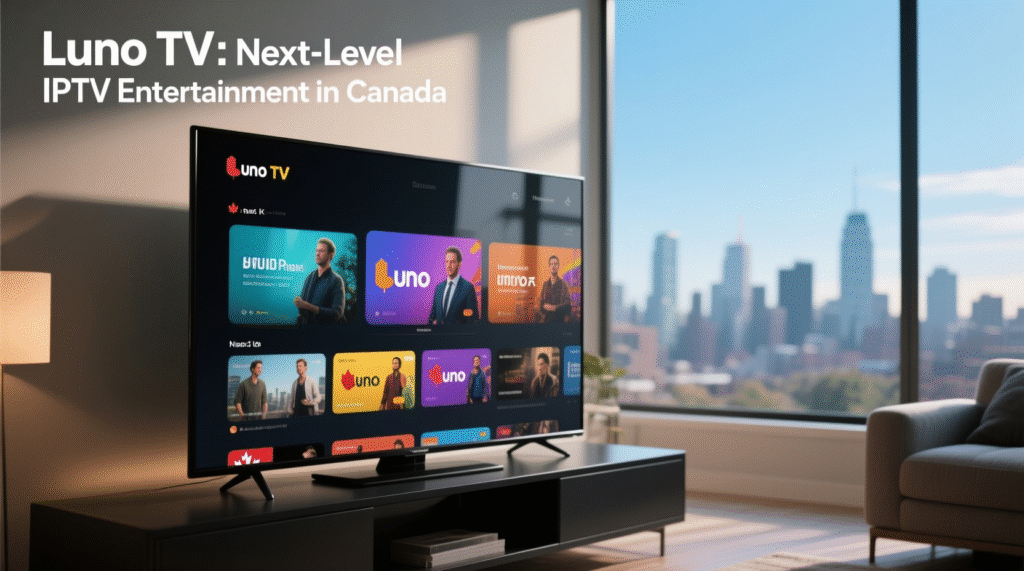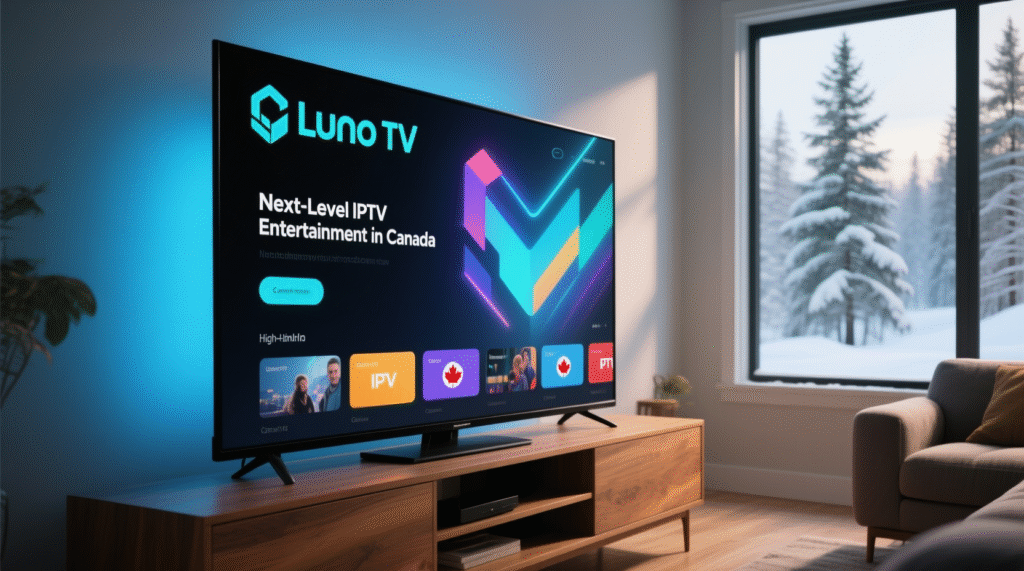Luno TV sets the scene for how Canadians now explore IPTV options, from app-based live channels to on-demand bundles tuned to provincial tastes.
This introduction gives clear info about what to expect: how services stack up on regional lineups, language support in English and French, sports access, device compatibility, and data or network limits that matter during peak hours.
Next-level services blend live channels, cloud DVR, large on-demand libraries, and multi-profile controls. They also favor transparent month-to-month pricing and easy cancellation to keep choices flexible for households.
We’ll explain how Canadian broadcasting rights shape channel availability and why checking Roku, Amazon Fire, Apple TV, Android TV/Google TV, Samsung, and LG smart apps, and mobile or desktop clients matters for travel viewing.
Practical guidance will cover privacy, parental controls, and basic internet planning (for example, 25–50 Mbps per 4K stream and the benefits of wired vs. Wi‑Fi setups) so readers can pick a reliable option without long-term risk.
Key Takeaways
- Compare regional channel lineups and language support before subscribing.
- Look for cloud DVR, on-demand libraries, and profile controls.
- Verify device compatibility across common streaming players and smart TVs.
- Plan internet speeds (25–50 Mbps per 4K stream) and prefer wired links when possible.
- Check privacy settings and parental controls for family use.
Understanding “Luno TV” in Canada’s 2026 IPTV Landscape
What people mean by the name often points to an internet-first service that replaces traditional cable with app-based live channels and large on-demand libraries. Canadians use this shorthand when they talk about streaming bundles that work across phones, web browsers, and smart devices.
Regional access and device expectations matter. Channel lineups change by province because of licensing; confirm access to CBC/Radio‑Canada, CTV, Global, Citytv, and regional sports networks before you commit.
By 2026, users expect polished apps on Roku, Fire, Apple, and Android/Google platforms, plus casting, mobile downloads, and reliable web playback. Performance benchmarks include adaptive bitrate streaming for 1080p/4K, low-latency sports modes, and an accurate EPG for scheduling.
How to evaluate value
Compare tiers by channel relevance, premium add-ons, DVR hours, and simultaneous streams. Test with a short trial: check internet speed at the set-top location, channel switch latency, on-demand buffering, and parental controls.
- Check account portability for travel and cottage use.
- Confirm 24/7 support, outage dashboards, and stepwise setup help.
- Document must-have channels and features before you edit your shortlist.
Luno TV: Offerings, Prospective Features, and How to Get Started
A strong, quotes, modern streaming package should deliver stable live channel playback, wide on-demand choices, and a cloud DVR that handles series recording and conflicts. Canadians expect generous retention caps and the ability to edit recording lists without losing shows.
Core viewing experience
Live channels must stream smoothly at peak hours, with adaptive bitrate and consistent frame rates for sports. On-demand libraries need robust catch-up options and smart recommendations.
Cloud DVR should allow series recordings, resolve conflicts automatically, and offer fast-forward where rights permit. Retention policies must be clear to avoid surprise deletions.
Setup basics and account safety
Verify app availability on your main devices and confirm simultaneous stream limits for multi-TV homes. Prioritize wired Ethernet or Wi‑Fi 6/6E and plan for 10–15 Mbps per HD stream or 25–50 Mbps per 4K stream.
Expect 4K HDR and 5.1/Dolby Atmos support when rights allow. Use profile-level parental controls with Canadian ratings, PIN protection, and bilingual settings for families.
- Try free trials and test peak-hour performance.
- Confirm billing transparency and in-app cancellation.
- Check closed captions, descriptive audio, and remote shortcuts for accessibility.
- Keep an indoor antenna as a backup for local channels during outages.
- Protect accounts with strong passwords and two-factor authentication.

"Plan internet headroom and confirm device compatibility before you subscribe — it saves time and prevents surprises."
Don’t Confuse Luno TV with “Luno the White Stallion” (1963-1965): Production Info and Cast
Clarify the difference: the modern streaming service name and the mid-20th-century cartoon are unrelated. The archival property, often called luno white in searches, is a Terrytoons creation from 1963–1965 and not a digital platform.
Production snapshot: the shorts were produced by William Weiss and directed by Connie Rasinski and Arthur Bartsch. The stories follow a boy, Tim, whose toy horse comes to life when he speaks a magic phrase.
The run includes six theatrical shorts released between 1963 and 1964, plus eleven backup segments that aired on Terrytoons anthology shows. Five Astronut-produced shorts were later reissued theatrically in the mid-1970s.
| Feature | Detail | Year(s) | Notes |
|---|---|---|---|
| Production info | William Weiss; Connie Rasinski & Arthur Bartsch | 1963–1965 | Terrytoons studio practices: theatrical and TV use |
| Theatrical shorts | The Missing Genie; Trouble in Baghdad; Roc-A-Bye Sinbad; King Rounder; Adventure By the Sea; The Gold Dust Bandit | Apr 1963 – Oct 1964 | Six initial releases |
| TV segments | Backup pieces on The Astronut Show and Deputy Dawg | 1963–1965 (reissues mid-1970s) | Eleven segments; five reissued theatrically |
| Main cast | Bob McFadden (horse); Norma MacMillan & Dayton Allen (Tim) | 1963–1965 | IMDb credits include an Aug 23, 1965 listing |
"Oh winged horse of marble white, take me on a magic flight."
Research tip: when looking for modern streaming information in Canada, add terms like "streaming," "IPTV," or "channels" to your query to avoid archival production records. If you need to edit search queries, include dates or "production info" to narrow results.

Conclusion
Summary info: when comparing streaming bundles in Canada, focus on provincial channel rights, bilingual support, sports coverage, and transparent pricing with clear device limits.
For a smooth setup, ensure your household has enough bandwidth per stream and prefer wired links when possible. Test cloud DVR, on-demand playback, and parental controls during a trial to confirm performance.
Clarification: do not conflate the modern streaming offering with the mid-century cartoon. The archival production info for the 1963–1965 "Luno the White Stallion" is distinct and unrelated.
Use a short checklist: list must-have channels, verify platform compatibility, and confirm customer support quality before you commit. Prioritize reliability, content relevance, and strong account controls so your chosen service delivers genuinely next-level entertainment for Canadian homes.

